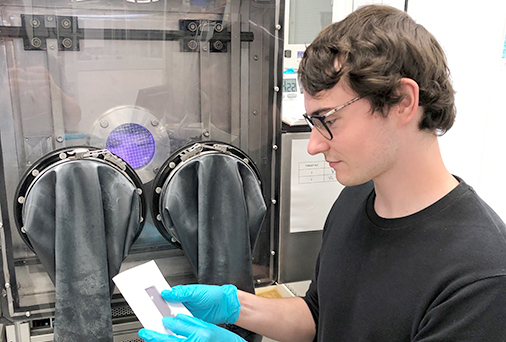Joseph Lawton
Industrial Fellow 2020
Remote Plasma Sputtering of High Quality Thermochromic Thin Films for Energy Conservation
Plasma Quest Ltd
University of Surrey
Finding better ways of insulating windows is a key component in reducing emissions caused by air-conditioning and heating. Joe is developing a coating for windows that will reduce the amount of infrared radiation that can pass through without reducing visibility, thereby making homes more energy efficient.
Windows present a major challenge in the design of energy efficient buildings because they transmit more infrared radiation in and out than ceilings and walls. The growth in demand for cooling systems in hotter climates will cause a significant rise in our future electrical usage, which means that improving windows’ energy efficiency and controlling solar heating is crucial for reducing future global energy consumption. Vanadium dioxide is a good candidate for producing an insulating coating for smart energy-efficient windows as it has thermochromic properties, meaning it can change its properties at a specific temperature, from letting solar infrared radiation through to heat buildings when the outside is cold, to being reflective on warm days, producing a cooling effect.
One of the major challenges with vanadium dioxide is that high temperatures are required to deposit the material onto a surface while maintaining their thermochromic properties. To overcome this challenge Joe is using Plasma Quest Limited’s proprietary HiTUS (high target utilisation sputtering) technique to develop a low temperature, plastic-compatible deposition process. Unlike conventional sputtering, the HiTUS technique generates and sustains a plasma (an ionised gas) without using the target (the material used for the coating). This remote plasma sputtering technique enables additional degrees of control over the processing space, resulting in a wider variety of achievable coating properties.
Following the completion of his Masters in natural sciences at Corpus Christi College, Cambridge in 2019, Joe joined the Engineering and Physical Sciences Research Council (EPSRC) Micro- and NanoMaterials and Technologies (MiNMaT) Centre for Doctoral Training at the University of Surrey, Guildford. Joe is currently pursuing an engineering doctorate in remote plasma sputtering of thermochromic thin film coatings for energy conservation.

“I was elated by the news from the Commission offering me the privilege of a place on the programme. The Industrial Fellowship has expanded the scope of my research, allowing me to explore the use of new technologies to overcome obstacles with current methods and provide greener solutions.”
